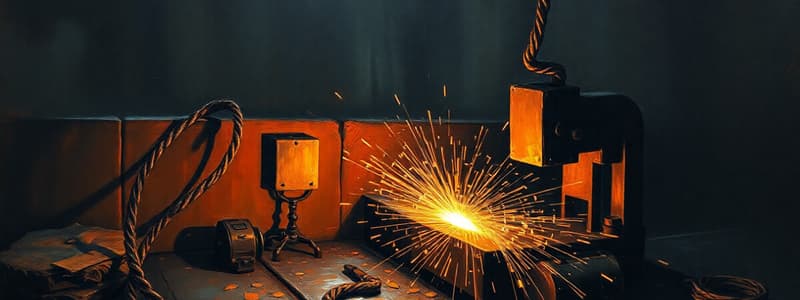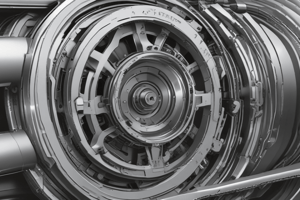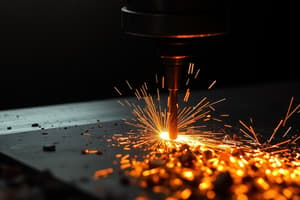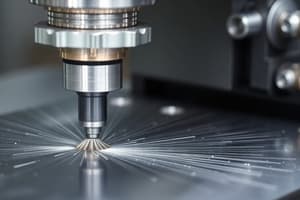Podcast
Questions and Answers
In metal cutting, what distinguishes oblique cutting from orthogonal cutting?
In metal cutting, what distinguishes oblique cutting from orthogonal cutting?
- Oblique cutting has an inclination angle between the cutting action and the job, whereas orthogonal cutting does not. (correct)
- Orthogonal cutting is a three-dimensional cutting process, unlike oblique cutting.
- Orthogonal cutting is the common type of cutting, unlike oblique cutting.
- Oblique cutting involves no relative motion between the tool and the workpiece whereas orthogonal cutting does.
Which type of machining operation is primarily used for producing cylindrical jobs?
Which type of machining operation is primarily used for producing cylindrical jobs?
- Planing
- Shaping
- Surface grinding
- Lathe Machining (correct)
What is the main characteristic of discontinuous chips formed during metal cutting?
What is the main characteristic of discontinuous chips formed during metal cutting?
- They are formed as a single, continuous piece.
- They are produced in the form of small, individual pieces. (correct)
- They reduce the tool life significantly.
- They result in a poor surface finish.
What is the 'built-up edge' phenomenon in metal cutting?
What is the 'built-up edge' phenomenon in metal cutting?
What type of material is most likely to produce continuous chips during machining?
What type of material is most likely to produce continuous chips during machining?
Which of the following processes is least likely to be used for machining prismatic jobs?
Which of the following processes is least likely to be used for machining prismatic jobs?
What is the function of a wedge-shaped tool in traditional machining processes?
What is the function of a wedge-shaped tool in traditional machining processes?
How do discontinuous chips typically affect the surface finish and tool life, compared to continuous chips?
How do discontinuous chips typically affect the surface finish and tool life, compared to continuous chips?
What conditions primarily contribute to the formation of a 'built-up edge' on a cutting tool?
What conditions primarily contribute to the formation of a 'built-up edge' on a cutting tool?
What is the primary characteristic of orthogonal cutting?
What is the primary characteristic of orthogonal cutting?
Which of the following is NOT typically considered a conventional machining process?
Which of the following is NOT typically considered a conventional machining process?
Which machining operation is commonly employed to create threads on a workpiece?
Which machining operation is commonly employed to create threads on a workpiece?
If a machining process results in small pieces of chips being produced, which of the following materials is MOST likely being machined?
If a machining process results in small pieces of chips being produced, which of the following materials is MOST likely being machined?
What is the purpose of 'center drilling' in machining operations?
What is the purpose of 'center drilling' in machining operations?
What is the function of the 'tail stock' in a lathe machine?
What is the function of the 'tail stock' in a lathe machine?
Flashcards
What is metal cutting/machining?
What is metal cutting/machining?
Metal cutting or traditional machining, also known as conventional machining, involves removing material to shape a workpiece.
Types of machining jobs
Types of machining jobs
Machining jobs are mainly cylindrical or prismatic (flats).
Machining methods for cylindrical jobs
Machining methods for cylindrical jobs
Cylindrical jobs are machined using lathe, milling, drilling, and cylindrical grinding.
Machining methods for prismatic jobs
Machining methods for prismatic jobs
Signup and view all the flashcards
Orthogonal cutting
Orthogonal cutting
Signup and view all the flashcards
Oblique cutting
Oblique cutting
Signup and view all the flashcards
Discontinuous chips
Discontinuous chips
Signup and view all the flashcards
Continuous chips
Continuous chips
Signup and view all the flashcards
Continuous chips with built-up edge
Continuous chips with built-up edge
Signup and view all the flashcards
Lathe machine
Lathe machine
Signup and view all the flashcards
Facing (Lathe operation)
Facing (Lathe operation)
Signup and view all the flashcards
Taper turning
Taper turning
Signup and view all the flashcards
Contour Turning
Contour Turning
Signup and view all the flashcards
Threading (Lathe Operation)
Threading (Lathe Operation)
Signup and view all the flashcards
Drilling (Lathe Operation)
Drilling (Lathe Operation)
Signup and view all the flashcards
Study Notes
- Metal cutting or traditional machining processes are also known as conventional machining processes.
- Machining processes are carried out in machine shops or tool rooms.
- A cylindrical or flat job is machined to a desired shape, size, and finish from a rough block using a wedge-shaped tool.
- The cutting tool removes metal in the form of a chip.
- Two main types of machining jobs: cylindrical and flats or prismatic.
- Cylindrical jobs are machined using lathe, milling, drilling, and cylindrical grinding.
- Prismatic jobs are machined using shaper, planner, milling, drilling, and surface grinding.
Metal Cutting Operation Classification
- The position of a cutting tool's cutting edge determines if a cutting operation is orthogonal or oblique.
- In orthogonal cutting, no force exists in the direction perpendicular to relative motion between tool and work piece.
- Oblique cutting, a common 3D cutting type, involves the cutting action being inclined with the job at an inclination angle.
Types of Chips
- Discontinuous chips.
- Continuous chips.
- Continuous chips with a built-up edge.
Discontinuous Chips
- Discontinuous chips come out during machining.
- The chip is produced in small pieces.
- These chips are obtained while machining brittle material such as cast iron, brass, and bronze.
- Fairly good surface finish is obtained and tool life is increased with this type of chips.
Continuous Chips
- Continuous chips come out during machining.
- These chips are obtained with ductile materials like mild steel and copper.
- A continuous chip comes from the cutting edge of a cutting tool as a single piece.
Continuous Chip with Built-Up Edge
- The temperature rises during cutting, and as the hot chip passes over the face of the tool, alloying and welding may occur due to high pressure.
- This results in the formation of weak bonds in the microstructure, and weakened particles might pull out.
- High heat and pressure cause these particles to weld to the cutting tip of the tool, forming a false cutting edge known as a built-up edge.
Studying That Suits You
Use AI to generate personalized quizzes and flashcards to suit your learning preferences.





